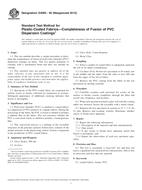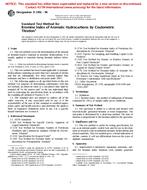1.1 This test method for ultrasonic examination applies to turbine and generator steel rotor forgings covered by Specifications A 293, A 469, and A 470. This standard shall be used for contact testing only.
1.2 This test method describes a basic procedure of ultrasonically inspecting turbine and generator rotor forgings. It shall in no way restrict the use of other ultrasonic methods such as reference block calibrations when required by the applicable procurement documents nor is it intended to restrict the use of new and improved ultrasonic test equipment and methods as they are developed. The procedure utilizes different calibration techniques than had been used in previous issues. The frequency or amplitudes of recordable indications should not be interpreted necessarily as a change in quality of the product being examined.
1.3 This test method is intended to provide a means of inspecting cylindrical forgings so that the inspection sensitivity at the forging center line or bore surface is constant, independent of the forging or bore diameter. To this end, inspection sensitivity multiplication factors have been computed from theoretical analysis, with experimental verification. These are plotted in Fig. 1 (bored rotors) and Fig. 2 (solid rotors), for a true inspection frequency of 2.25 MHz, and an acoustic velocity of 2.30 × 105 in./s (5.85 × 105 cm/s). Means of converting to other sensitivity levels are provided in Fig. 3. (Sensitivity multiplication factors for other frequencies may be derived in accordance with X1.1 and X1.2 of Appendix X1.)
1.4 Considerable verification data for this method have been generated which indicate that even under controlled conditions very significant uncertainties may exist in estimating natural discontinuities in terms of minimum equivalent size flat-bottom holes. The possibility exists that the estimated minimum areas of natural discontinuities in terms of minimum areas of the comparison flat-bottom holes may differ by 20 dB (factor of 10) in terms of actual areas of natural discontinuities. This magnitude of inaccuracy does not apply to all results but should be recognized as a possibility. Rigid control of the actual frequency used, the coil bandpass width if tuned instruments are used, etc. tend to reduce the overall inaccuracy which is apt to develop.
1.5 This test method for inspection applies to solid cylindrical forgings having outer diameters of not less than 2.5 in. (63.5 mm) nor greater than 100 in. (2540 mm). It also applies to cylindrical forgings with concentric cylindrical bores having wall thicknesses of 2.5 (63.5 mm) in. or greater, within the same outer diameter limits as for solid cylinders. For solid sections less than 15 in. (381 mm) in diameter and for bored cylinders of less than 7.5 in. (190.5 mm) wall thickness the transducer used for the inspection will be different than the transducer used for larger sections.
1.6 This standard does not purport to address all of the safety concerns, if any, associated with its use. It is the responsibility of the user of this standard to establish appropriate safety and health practices and determine the applicability of regulatory limitations prior to use.
Product Details
- Published:
- 10/01/2003
- Number of Pages:
- 7
- File Size:
- 1 file , 140 KB


